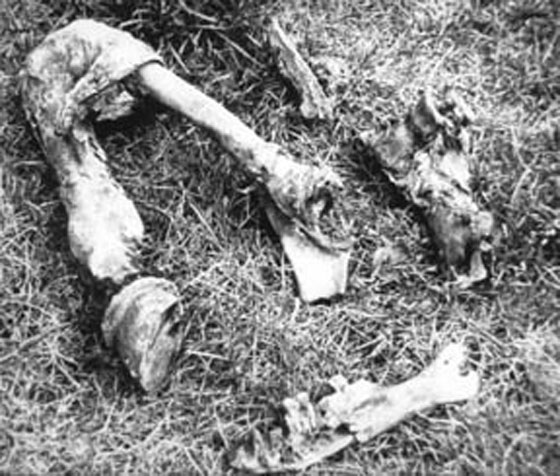
Photo by Whitehorse Star
Important unearthing - The specimens found near Dawson City have been described as the best of their kind discovered in North America. Yukon government photo

Photo by Whitehorse Star
Important unearthing - The specimens found near Dawson City have been described as the best of their kind discovered in North America. Yukon government photo
Carbon-dating an Ice Age horse's remains found by placer miners this fall shows the animal is more than long in the tooth - the Yukon Ass is 26,000 years old.
Whitehorse Star, December 24, 1993
Horse remains found near Dawson City are 26,000 years old
Carbon-dating an Ice Age horse's remains found by placer miners this fall shows the animal is more than long in the tooth - the Yukon Ass is 26,000 years old.
The dark chestnut brown hide is complete with blonde mane and tail, and a right foreleg with the flesh remaining. They were dug out of the muck layer just above the gold-bearing gravels.
As well, a scapula, humerus, and stomach contents were recovered from the Last Chance Creek site near Dawson City.
"We're very excited. This is a very significant find in terms of understanding Ice Age animals, and it gives us a window into life in the Ice Age," Yukon government archeologist Ruth Gotthardt said in an interview this week.
For example, artist's depictions have shown the small horse as having short manes and tails, but this animal had a long mane and tail and beautiful coat, she said.
The hide is being cleaned and freeze-dried so it can be preserved and displayed.
Gotthardt pulled the remains of the pleistocene horse from the muck wall in September.
"I've never been so happy digging something up."
The remains were so well-preserved that intestinal membranes are distinguishable, complete with fresh dung. And it smelled strongly of dead horse, even though the animal died 26,000 years ago, she added.
"We collected enough dung for specialists in botanical fossils and pollen to see what these animals ate."
This is significant because the flora during this slightly-warm glacial period is the source of much scientific debate.
As well, parasites on the hide or in the dung can be studied, and DNA tests of the soft tissue could show how closely-related these animals are to the modern horse.
Plans are in the making for archeologists to return to the site and see if any more remains can be found, or if there are any other animals preserved there.
Lee Olynyk and Ron Toews made the find, and called the heritage branch because they suspected it was significant.
They knew the ground they were working well, and realized there was no mine shaft or other disturbance to account for the horse having been placed there recently, said Gotthardt.
She stressed the importance of cooperation with the mining industry in making and preserving these pieces of history.
The remains are the best-preserved examples of an Ice Age animal found in North America, she said. A black-footed ferret, part of a steppe bison, and Arctic ground squirrels have also been found mummified.
Chances of finding an animal from the past in the flesh are remote, because a unique set of circumstances are necessary to preserve the flesh. As well, they are buried 20 metres deep, and heavy equipment and a good measure of luck are need to unearth them.
Gotthardt speculates that the horse may have died in the creek, as the site is an old creek bed. An overhanging bank may then have collapsed on top of it, cutting off oxygen and preventing decomposition.
The Yukon offers the best paleontological record for late Ice Age animals because it was not glaciated in this period. The Dawson and Old Crow areas have provided the most specimens.
In order to encourage thoughtful and responsible discussion, website comments will not be visible until a moderator approves them. Please add comments judiciously and refrain from maligning any individual or institution. Read about our user comment and privacy policies.
Your name and email address are required before your comment is posted. Otherwise, your comment will not be posted.
Be the first to comment